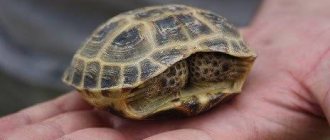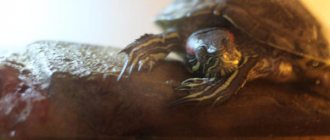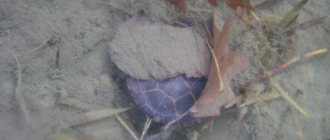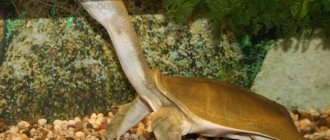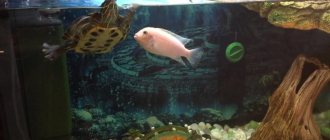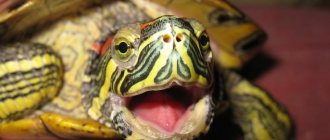There are several different species of red-eared turtles, which vary in size. They are not difficult to keep at home, but some species require organization of sleep and in this regard, the owners have a number of questions:
- Does a red-eared turtle need hibernation if it is not in natural conditions?
- Why do they hibernate?
- What needs to be done to prevent the turtle from falling asleep?
- What is the function of hibernation for turtles?
- What is the red-eared slider's sleep period?
Is it possible to sleep in a refrigerator?
Biologists recommend placing turtles in the refrigerator during hibernation, because it is easy to maintain the same temperature.
First, the turtle is placed in a cardboard box, which is not much larger in size than the animal, the voids are filled with torn paper, and placed in a refrigerator with a temperature of +12 degrees. The temperature is reduced every day by 1 degree until it reaches +5. To overwinter in the refrigerator, the turtle can be buried in a substrate of turf soil, sand and fine gravel. The layer of mixture above the turtle should be within 8-9 cm, but to prevent it from suffocating, the refrigerator door must be opened for 10-15 minutes every 2 days.
Setting up an aquaterrarium
For one ward you will need a 100-liter aquarium; a couple of different sexes will need a capacity of 150 liters or more. Next, we create the interior of the turtle’s home, taking into account the fact that land should occupy approximately 25% of the area of water. At the same time, let’s not forget our interests – the beauty of the aquaterrarium. If you wish, you can purchase an artificial shore at a pet store, but then you won’t get a real corner of wildlife. But you want not only to keep the red-eared turtle, but also to enjoy the whole composition.
We will be guided by the last condition:
- Place a large stone with a flat surface at the end of the aquarium. When calculating its size, take into account the distance from the top edge of the future aquaterrarium - it should not exceed 40 centimeters.
- If the land slope is not gentle enough, you need to make a bridge to it from the water. Frequent, stable steps made of smaller stones or suitable driftwood without jagged edges will do.
- Next, we fill the soil not only at the bottom. Be sure to fill the space between the walls with stone and under the bridge. If this is not done, even though it is aquatic, the reptile may get stuck there and drown. The size of the soil also matters - red-eared turtles can swallow small pebbles and die.
- Living bottom plants will be quickly eaten. Therefore, it is better to choose emergent species with a root system located in ceramic pots or other reliable decorations at the bottom. For example, dwarf papyrus, water hyacinth and similar vegetation.
We will return to the small but important details of the interior later. Now it’s time to pour water into the almost finished aquaterrarium. Let's start with its parameters - temperature 22-28ºС, soft like peat, with neutral acidity. It is important to take into account the water level - it should be such that a turtle turned over on its back can find support on the bottom or decorations and independently return to its original position. Now regarding the required equipment:
- A good external filter for the red-eared turtle is very important because it feeds and defecates directly in the water.
- To heat the shore, you need a regular 40W lamp located directly above it. Stronger light bulbs can only be installed at a distance from land above fifty centimeters - otherwise burns cannot be avoided. The optimal temperature of a dry surface should not exceed 35ºС.
- Ultraviolet lamp for reptiles. It makes more sense to purchase it in a specialized store. It is better not to experiment with UV lamps intended for humans - the wavelength is completely different and the reptile’s body will not produce the vitamins necessary for the absorption of calcium.
- Thermostat to maintain a constant water temperature. When purchasing it, make sure that you need a model that is suitable for the aquaterrarium.
After the housing for the aquarium red-eared turtle is ready, it is recommended to let it stand without a pet for at least a couple of days. By the way, it needs to be positioned so that it is not exposed to direct sunlight. While the water is settling, there is time to go to pet stores in search of a “new home.”
How to tell if a turtle is sick or hibernating
As a rule, turtles kept in apartments do not need long hibernation. With the onset of seasonal cold, in October-November, the inhabitant of the aquarium may slightly change her behavior. She loses her appetite and sleep duration increases. But she is unlikely to hibernate, since the apartment is quite warm and light, and her own “home” is also additionally illuminated.
On the other hand, the behavior of a turtle, which its owners regard as hibernation, can be a dangerous and sometimes fatal disease. Therefore, if the apartment is warm, and the turtle is sleeping, you should sound the alarm. The first thing you need to do is touch it: if the head and limbs are extended and do not respond to touch, it is likely that the pet has died. When a living turtle gets into warm water, it will definitely begin to move its legs and try to swim. Another sure way to determine if a turtle is alive is to check the corneal reflex. If the eye does not react to the touch of any object, then the turtle has died.
Hibernation is often confused with suspended animation, a condition that suppresses the body’s vital functions. Unlike suspended animation, hibernation is a natural process characterized by a more superficial suppression of general activity and internal processes.
Let's figure out how hibernation occurs in red-eared turtles and by what signs it can be determined.
Aquatic turtles hibernate (winter) when temperatures are too low, falling below 15° and remaining at this level for a long time. The reptile goes underground and sleeps until the temperature rises in a dug hole.
Red-eared turtles hibernate when winter arrives and do not emerge from it until early spring. Their sleep lasts from 4 to 6 months and depends on the size of the reptile. The smaller the turtle, the more time it needs to sleep.
How do turtles sleep?
Aquatic turtles (red-eared, marsh) can sleep both on land and under water.
Sleep can also catch them during a walk, when the owner releases the animal from the aquarium. Therefore, you need to do this only for a few hours and periodically monitor your pet so that it does not get lost or get stuck in hard-to-reach places. Most often, domestic red-eared turtles sleep on land. They climb onto the island, close their eyes, calm down and fall asleep. Some animals retract their head and paws into their shell, while others do not. They leave their head extended and simply close their eyes. This happens because they get used to a calm environment, the absence of predators and competitors.
However, the red-eared turtle can also sleep in water. A sufficient amount of air accumulates in her lungs, the supply of which lasts for several hours. The animal sleeps in the water, completely submerged there, or stands on its hind legs on the bottom of the aquarium, and rests its front legs on an island or other object. The pet can spend several hours in a row in this position.
Preparation
So, how do red-eared turtles hibernate at home? About 2 months before hibernation, switch your pet to an enhanced diet so that she can store as many nutrients as possible
This is important because during hibernation animals lose weight by almost 2 times. It is useful to give your turtle special nutritional supplements (they are sold at the pet supply store)
But a week before bedtime, the animal needs to stop feeding altogether.
The ideal temperature during sleep is from 1 to 6 degrees Celsius. This regime can be ensured by placing the animal, for example, in the basement. However, be careful. Hypothermia is fatal for red-eared turtles. It is also necessary to maintain optimal humidity conditions. It can be provided by moistened moss and leaves. This environment is well ventilated.
Factors affecting red-eared slider sleep
The first factor affecting a reptile's sleep is its activity level. The duration of sleep depends on how active the pet is. If the turtle doesn't move much, it won't sleep very long. But with a very active lifestyle and great mobility, the reptile will succumb to sleep for a longer time.
Another factor is the gender of the reptile. It is impossible to distinguish between individuals at a small age, and no one can do this. The sex of a turtle can be determined at a later age. It is necessary to compare the length of the tail of individuals, since the male will have it longer, as well as the length of the claws, which will also exceed the females in importance.
Sometimes, during the occurrence of certain types of diseases, the turtle’s life cycle is disrupted, and in turn can cause very long sleep, or, conversely, its complete absence.
It is impossible to say exactly how long turtles sleep when kept at home. Since a reptile’s sleep directly depends on the created living conditions, as well as on the character of the individual itself.
Did you like the article? Take it to your wall and support the project!
Do you want to have a hypoallergenic, quiet, interesting pet that does not require walking and at the same time decorate the interior of your home? Then the decorative red-eared turtle will be an excellent option. How to care for it and what is required for this will be discussed below.
How to prepare a turtle for hibernation in captivity?
Important: Never try to hibernate a turtle if it has recently eaten.
As autumn approaches, turtles eat less and less - this is a natural process. The functioning of the animal's digestive system mainly depends on air temperature. When biological processes slow down, the body needs 2-4 weeks for the last food eaten to completely pass through the digestive tract. Therefore, it is best not to attempt to hibernate a tortoise if there is a possibility that there may be undigested food left in the intestines. This is very dangerous: the gases released can cause potentially fatal colic. To properly prepare your turtle for hibernation, give it a period of fasting that should last at least three weeks. It should be noted here that the exact time depends on the size of the reptile (small turtles need less time for the hunger period, large ones need more). During this period, the animal should be kept at a temperature slightly lower than normal. It is also necessary to gradually reduce the lighting level.
Particular care should be taken to monitor the turtle's health during the period immediately preceding hibernation. If you suspect that your turtle is unwell, do not try to hibernate it under any circumstances. This may result in the death of the animal. The same applies to turtles that weigh below normal. If you are not sure of the complete health of the turtle, it is recommended that it overwinter in a warm, dry and ventilated terrarium. It is also undesirable to hibernate animals that you have recently acquired.
When and how long do they sleep?
The answer to this question is ambiguous, since each animal develops its own habits over time. The duration of sleep and the characteristics of biorhythms depend on a number of factors:
- Gender
: Males have been found to sleep longer than females. Males can be distinguished by their more powerful paws and long tail. - Age
: young individuals are very active, they can swim around the aquarium all day, play, run around the room if the owners let them out. As a result, such turtles fall asleep for several hours, just like a person. They get very tired and can sleep all night. An old turtle often falls asleep on the go, it is slow and behaves calmly, so it requires less time to sleep. - Health status
: if the pet is cheerful and behaves as usual, nothing threatens its health. But sometimes the animal can become slow, falling into a kind of hibernation for 5-7 days in a row or more. Inexperienced owners may even think that the reptile has died, although in fact it is simply resting to recuperate. - Individual characteristics
: it is not the duration of sleep that depends on them, but biorhythms, i.e. time of falling asleep and waking up. There is no general law here: some turtles like to sleep during the day, after which they make noise all night. Others, on the contrary, fall asleep at night because during the day they are disturbed by light, noise from people, household appliances, etc.
Description of the species
Red-eared turtles in nature reach 30 cm in length (based on the shell), but when kept at home they rarely grow to that size. Females are significantly larger than males. The shell of juveniles is bright green, but as the turtle matures it becomes brown or olive in color with patterns of bright yellow stripes.
The head, neck and paws of the animal are decorated with a series of white and black stripes. The species got its name due to the bright red spots near the eyes. These “ears” can also be deep orange or rich yellow. It is thanks to its bright appearance that the red-eared turtle has become one of the most popular exotic pets.
She prefers to lead a sedentary lifestyle, but swims very quickly in the water and is extremely curious. May hiss and snort, expressing his displeasure and anxiety. When defending its life, it can inflict serious wounds with the sharp claws of its hind legs. In the cold season, a phenomenon called suspended animation, or hibernation, occurs for red-eared turtles.
What to feed red-eared turtles
The diet of turtles is quite extensive. When young, they can be fed dried crustacean mixtures purchased from a pet store (dried hemarus). A resident of a home terrarium will also be happy to eat earthworms, bloodworms, minced meat and beef liver.
The diet of an adult turtle must include “vegetable dishes”. Lettuce greens, leaves of carrot or beet tops, pieces of vegetables and fruits - these products are simply necessary for the turtle.
The first wintering of a marsh turtle
Surprisingly, little turtles go into their first winter hibernation immediately after birth, without ever leaving their nest. The thing is that the habitat of swamp turtles is often not pleasant in the long summer, so warm days are only enough for small turtles buried deep in the sand to form in their shells. Reptile eggs are completely dependent on the sun, so warm days are only enough for the turtles to hatch, since the incubation period ranges from 54 to 90 days, depending on the ambient temperature.
Turtles hatch in mid-autumn, when it is already starting to get colder and there is not enough food for them, so they do not leave their underground nest, hibernating where they emerged from the shell. Turtles do not have stored fat, but they have large sacs of yolk on their abdomens, which help them survive the winter cold while hibernating. Newborn turtles are literally frozen in their nests, but when spring arrives, they wait again and emerge into sunlight for the first time.
Types of turtles
There are many different species of turtles in the world. They vary in color, size and nutrition. Most turtle species are diurnal. In places where it is quite hot during the day, they become crepuscular, meaning they feed only during the cooler periods of dawn and dusk.
There are several concentric rings on the top shell or shell of a turtle. These patterns are very similar to the cross section of a tree. Circles can sometimes give clues as to the age of an animal, but this method of determining age is not reliable since their growth depends on the availability of food and water. A turtle with access to plentiful food, or one that is fed regularly by its owner without any seasonal changes, will not have easily visible rings. Some turtles develop more than one ring per season, and on some turtles the rings may not be visible due to wear and tear.
How to properly bring a turtle out of hibernation
In order to properly remove an animal from wintering, it is worth performing all of the above steps, only in reverse order. It is necessary to initially increase the temperature in the room, then carry out digging procedures and only then offer the animal food and water. Ideally, red-eared turtles emerge from hibernation five days after they begin to awaken.
If after the specified time no changes in the pet’s condition have occurred, you should definitely seek help from a veterinarian, who will recommend how to correctly carry out this process without losses to the animal’s body.
Under natural conditions, leaving hibernation is a normal process that goes away on its own, but at home it is quite difficult to wake up a reptile. It is also worth noting that a sufficiently large number may die after entering hibernation due to various diseases and sufficiently weakened immunity.
If you are a conscientious owner and take proper care of your pet’s health, namely, nourish his body on time with vitamins and microelements, and also organize proper nutrition for him, then the wintering regime will pass without consequences, and the animal will only regain its strength for the entire next year.
How to avoid wintering?
To prevent the turtle from hibernating, make sure that there are optimal temperature conditions for keeping it:
- Water
. The temperature should be 22°-28°. Any decrease will lead to a decrease in activity and a gradual slowdown of internal processes. - Land
. The island is used by turtles for heating, so the temperature here can reach up to 32°.
The cause of hibernation can also be a lack of vitamins. Make sure you have enough or get a vitamin shot at your veterinarian. This will prevent the turtle from hibernating due to lack of nutrients.
Due to the labor-intensive process and high risks, it is not recommended to put the reptile into hibernation. If in nature the process occurs naturally and its time is determined by biological rhythms, then at home the responsibility falls solely on the owner.
How and when do aquatic red-eared turtles hibernate at home?
5 (100%) 2 votes
Rules for caring for a sleeping turtle
If you notice the first signs of the approaching winter in a red-eared slider, be sure to consult with a veterinarian, who will examine it and tell you what needs to be done if the reptile actually hibernates.
During the winter, adhere to the following recommendations:
- Lower the water level
. The turtle burrows into the ground, where it can sleep for a long time without rising to the surface. Oxygen is obtained by special membranes in the cloaca and oral cavity. - Turn off additional lighting
. The pet will have to go to the bottom to maintain warmth, so turn off the filtration and monitor the water level. Excessive movement will destroy the thermal layer, and a low water level will lead to freezing to the very bottom. - Avoid feeding
. Thanks to slow digestion, the turtle digests the food eaten the day before over the course of several months. - Monitor your pet's well-being
. Domestic turtles fall asleep as early as November, when daylight hours begin to shorten, and sleep for about 4 months. It happens that the reptile does not wake up even in February. In this case, you have to wake up the pet yourself.
If the turtle looks active or it is February, then gradually increase the temperature and light to normal. The recovery period takes from 5 to 7 days.
You can feed your pet only after returning to normal activity, but not earlier than the 5th day.
Signs of hibernation
The state of wintering is often confused with death. To put your mind at ease, check your red-eared slider for several points that will help you understand that it is definitely hibernating:
- Jaws
. Try to pull your lower jaw down and leave your mouth open. The reptile should try to close its jaws. - Eyes
. A cold metal spoon placed against your pet's eye should trigger the corneal reflex. If the turtle tries to retract the disturbed organ or opens its eyelids, then there is no reason to worry. - Reaction to heat
. A hibernating red-eared turtle placed in a container of warm water (30°C) will begin to move its paws.
Otherwise, signs of hibernation include:
- Decreased activity
. The pet behaves lethargically, hides in a corner of the aquarium, remaining motionless, and refuses to leave its house for a walk. - Poor appetite
. In addition to loss of activity, the reptile refuses its favorite food and reduces its usual amount of food. - Increased sleep duration
. Long periods of rest are accompanied by frequent yawning.
Pleasant awakening
Coming out of hibernation is an important moment in the life of a turtle, and it needs help to cope with this task. How to bring a turtle out of hibernation? All autumn reserves are used up, the turtle wakes up weak, exhausted and vulnerable to infections. At this moment, she needs care and quality nutrition more than ever.
After the turtle comes out of hibernation, it is warmed with a lamp or fan heater, then a “bath day” is arranged - in a small container with warm water. The turtle should bathe for about 10 minutes, this will restore the water balance in its body.
After hibernation, water procedures must be repeated every day for a week. They can be stopped when the reptile urinates for the first time. At first, her urine will be thick and dark yellow, but gradually the toxins will come out and it will become light in color again.
Now you can “sit down at the table,” of course, if its appetite has awakened along with the turtle. At first, the reptile may refuse food, this is normal, gradually everything will recover.
What signs can be used to determine that a turtle has safely emerged from hibernation? A healthy reptile's tongue will be pink or orange, without a coating. If it is bright red, the animal may be infected with something. The eyes should be clear and clean, also without plaque or discharge.
Hibernation is a completely natural process for turtles living in nature, but for indoor pets, wintering is often not relevant. This is a rather complicated procedure and a huge burden on the turtle’s body, so it is not recommended to hibernate turtles on your own, only under the supervision of a specialist.
The first signs that it is time for the animal to winter can be observed in late October - early November. The turtle becomes less active, its appetite decreases, it tries to bury itself in the ground or almost never leaves its shelter. In the natural environment, hibernation lasts from 3 to 5 months, all vital processes of the body slow down, and accumulated resources are used to maintain life. There are also advantages to wintering: it is indicated for turtles from which the owners plan to get offspring, since hormonal levels are adjusted, life expectancy increases, and the activity of the internal glands is maintained.
It is worth remembering that under artificial conditions hibernation should not be so long: for small breeds it is 8-10 weeks, for large breeds it is 12-14. The animal must be absolutely healthy, and a suitable microclimate must be maintained constantly, otherwise the turtle may not emerge from hibernation. If you are not confident in your abilities, it is easier to maintain normal conditions: temperature at 27-28 degrees, frequent bathing, good nutrition. Does your turtle eat well? – go to the clinic, a specialist will give her an injection of vitamins.
Diseases - prevention and treatment
Almost 90% of cases of diseases of red-eared turtles occur due to improper care, housing conditions and feeding, or all at once. If an animal is sick, do not treat it yourself, go to a specialist. A lot of situations require veterinary diagnosis.
Types of diseases
Pneumonia. The turtle becomes lethargic and cannot dive, although he tries. There may be discharge from the mouth or nose, and wheezing is common. As in humans, pneumonia can be unilateral or bilateral. The latter most often leads to death. The disease is most often caused by temperature changes - red-eared turtles are extremely thermophilic. Treatment may include inhalation with chamomile decoction. The pet must be periodically held over the container with it so that it inhales the medicinal vapors. The temperature of the steam must first be checked with your hand so that the turtle does not get burned. It is also important to remove sources of cold - otherwise treatment will be useless.
Rickets. This is a calcium deficiency caused by a lack of ultraviolet radiation and poor diet. For example, a purely meat diet leads to it. Red-eared turtles need both protein and fiber and carbohydrates. When sick, the reptile's skull and other bones do not soften, only the shell suffers. It softens and may become warped. Problems with feeding the red-eared slider may also arise. In the most advanced cases, the animal may die. Treatment consists of injections of calcium supplements, changes in diet and increased UV radiation.
Skin diseases. They are caused by an unbalanced diet, for example, a lack of vitamins A and B. The skin begins to peel off. It is necessary to strengthen your diet with foods high in these vitamins. But in order not to overdo it and cause hypervitaminosis, it is better to use special supplements - the vitamin content in them is strictly dosed. Additionally, you can take care of your skin using products prescribed by specialists.
Sepsis or blood poisoning. It mainly occurs as a result of injury to the skin, through which bacteria enter the blood directly from dirty water. Symptoms of sepsis may include weakness, passivity, and redness of the paws or shell. Treatment must be urgent and is carried out with antibiotics prescribed by a veterinarian.
Abscess in the ear. The most common cause in turtles is dirty water. The disease manifests itself as inflammation or swelling on the head. Since turtles do not have ear canals, treatment is carried out only by surgery under general anesthesia.
Conjunctivitis. The turtle's eyes become swollen or red and he cannot open them. There may be various discharges from the eyes. Turtles are prone to eye infections. The disease is contagious, and the sick turtle must be separated from the others. In order not to aggravate the disease, it can only be put into water for 1-2 hours a day. Treatment consists of antibiotic drops in the eyes. Ordinary human ones are suitable, for example Diclofenac. You also need to replace the water, clean the terrarium, and check the temperature. If you start therapy at the first symptoms, a couple of days of treatment will be enough.
Bacterial infection in the mouth. Symptoms will be formations in the mouth, usually necrotic in nature. The animal stops eating and may not open its eyes. This is a very serious condition that requires immediate treatment. The oral cavity should be periodically cleaned with a gauze swab with an antibiotic solution, removing the affected tissue. With timely treatment, it can be cured well.
Bacterial skin infection. Usually caused by bacteria that have entered the skin due to injury - a burn from a lamp, injury from sharp objects, or other illness. Symptoms will be a soft shell with visible hemorrhages. The affected area rapidly increases in size. There may be an unpleasant odor from the turtle. It is necessary to remove dead tissue and treat the affected area with antibiotics prescribed by a veterinarian until complete healing.
IMPORTANT: Red-eared sliders are recognized as carriers of salmonella bacteria. If these animals are handled incorrectly, people can become infected. This led to legal restrictions on their sales in a number of countries.
How to help a turtle hibernate
If you want the animal to hibernate, spend maximum time preparing the animal for it. Then the event will occur - red-eared turtle: suspended animation. Gradually lower the temperature of the water in the aquarium to the temperature most typical of the area where your turtle lives. Preparation should take from a week to ten days. To do this, you can replace incandescent lamps with less powerful ones or equip a special aquarium with wet sand for hibernation, where the animal can burrow.
In the next two months, after the onset of hibernation, be sure to check its condition and move it to more familiar conditions when it wakes up.
The animal should be fed 5 or 7 days after waking up. The temperature of the water in the aquarium should also be increased gradually.
The nature and characteristics of hibernation are individual for each animal. And therefore, the need for it, as well as its absence, will easily be revealed by the behavior of your turtle. Be attentive to your pet and you will easily understand what he needs for a full life in modern apartments.
Turtles, like many animals on our planet, hibernate. This is how they adapt to survive in conditions of seasonal temperature drops. However, hibernation in mammals is associated with a lack of food, while turtles fall asleep when the first cold weather sets in. There are a number of other factors that influence the seasonality of life. This includes the amount of food, body size, photoperiod, reproductive activity, and, ultimately, individual biorhythms. Individuals of the same species living in different climatic zones, different sexes and ages, may differ from each other in periods of hibernation.
The following stages of hibernation in turtles are distinguished:
1. As the temperature drops, turtles’ appetite decreases.
2. Finding a warm, secluded corner containing a sufficient amount of moisture (to prevent dehydration). But the lack of oxygen will not affect the health of reptiles in any way, because they tolerate its lack well.
3. During hibernation, metabolism slows down and the body needs only a small amount of energy to meet its needs. The source of this energy is fat, which accumulates in the liver and fat bodies. A small amount of it is consumed during hibernation, but the bulk of the fat is very necessary in the spring, when turtles wake up.
4. As the temperature rises, the stage of awakening from hibernation begins. Many turtles overwinter underground, so photoperiodism does not matter in this case.
Thanks to hibernation, the sexual cycles of breeding turtles are synchronized. A healthy turtle loses more than 10% of its body weight due to a decrease in fat and glycogen stores, as well as dehydration.
Turtles such as Trionyx spp. hibernate at the bottom of the pond. They are characterized by so-called “water hibernation.” Such reptiles breathe oxygen dissolved in water, receiving it through the skin.
a turtle need
living at home,
hibernating
?
A turtle living in a terrarium and receiving sufficient heat, moisture and ultraviolet radiation will not hibernate. This is the safest option for keeping an animal, because to properly organize wintering for reptiles, it is not enough to make every effort. It is also necessary to have experience that will help determine whether the tortoise is ready to winter. Therefore, if you are not going to use hibernation to stimulate sexual cycles, use a safer option - do not create conditions for hibernation for the turtle.
What do you need to know to properly organize hibernation for a turtle?
Bringing a turtle out of hibernation begins with a gradual increase in temperature. It should reach room temperature within 5 days. Then they turn on additional heating and bathe the turtle in warm water. After about a week, your pet will begin to eat. If the turtle refuses to eat, it means something went wrong and the animal needs to be treated urgently.
Breeding and reproduction
Breeding these animals at home is quite labor-intensive. Requires certain knowledge, some experience and the presence of an incubator.
Sexual differences between male and female
First of all, it is necessary to determine the sex of the animal. But turtles take a long time to mature and look almost the same in childhood. So it is possible to reliably identify their gender only after 7 years. There are several ways to do this:
- Abdominal shield or plastron. The shell of females is smooth underneath. In males it is modified - closer to the tail there is a notch on it. During mating, it adjoins the convex upper part of the female’s shell, facilitating a better fit of the genital organs to each other.
- Fingers and claws. Males have elongated fingers, and the claws are elongated and slightly curved.
Females have short fingers and almost no claws at all.
- Tail. The shape of the tail in males approaches triangular. Females have a straight and shorter tail.
- Muzzle. In males it is slightly pointed, and in females it is somewhat flattened. But this is only an additional sign.
- Activity. Males are more energetic. They constantly run or swim around their aquaterrarium, taste everything, and shake their heads. Females are calmer.
Conditions for reproduction
Physiological readiness for mating is determined by the length of the shell. Eleven centimeters are enough for a male, seventeen for a female.
An incentive for reproduction can be maintaining a temperature of at least 26°C, together with a gradual lengthening of daylight hours and lighting intensity. Turtles, especially females, spend significant resources on reproduction. Therefore, during mating and gestation, they need nutrition, including phosphorus, calcium and some vitamins.
To form pairs, several turtles are kept together. It is desirable that the proportion of males and females be maintained at one to two, otherwise there will be too much competition between males. Males ready to mate engage in fights, attracting the attention of females. If a pair has formed, it should be placed in a separate aquarium.
It requires a container with soil with a layer of at least 5 cm in which the turtle will lay eggs. Sand or peat is suitable as a filler. A lift must be attached to the container to allow the turtle to climb inside.
How do red-eared turtles reproduce?
The readiness to mate directly is indicated by the behavior of turtles. Males begin to tap on the shells of their partners and tickle their cheeks with their claws. The entire courtship lasts about 45 minutes. Females show their readiness by approaching the male and diving to the bottom.
Mating occurs in water no deeper than 12 centimeters and takes 10 minutes. This will allow the baby turtle to breathe during the process.
One mating is enough for 4-5 clutches of eggs with intervals between them of 2-5 weeks. At the same time, the female lays from 2 to 30 eggs. Towards the end of pregnancy, the female begins to look for a suitable place to lay eggs. It is very important because if it is missing, she will lay eggs in the water or continue to carry them further, which will lead to their hardening. This can cause infection and death of the animal.
The female digs a hole-nest in the ground using her hind legs. If the turtle has laid one or two eggs, then the clutch is most likely not finished, and you need to help her dig a hole.
Turtles do not care about their offspring in any way and abandon the clutch.
Egg development takes from 59 to 112 days. They need to be transferred to an incubator. They are homemade and industrial.
A homemade incubator for red-eared turtles is made according to the approximate diagram in the photo:
It is based on a closed glass or plastic container in which a cuvette with substrate and eggs is placed. There should also be a vessel with water for humidification, a heater to maintain temperature and a thermometer.
But you can also find industrial incubators for reptile eggs, such as the Zoo Med Reptibator Egg Incubator. It is equipped with a liquid crystal display and electronic temperature and humidity sensors. The temperature can be set in the range from 15 to 40°C, and humidity – from 10 to 95%. The transparent lid allows you to observe the eggs without opening the incubator.
The baby turtle remains inside the shell for two days after hatching. There they feed from the yolk sac, part of which still remains in the egg. But babies will be able to swim only after 21 days, when the place through which the yolk was absorbed has healed. Newborn turtles are kept separately from adults, as they can damage them.
Interesting: The sex of developing turtles depends on the soil temperature. If the sand heats up to 30 degrees or more, females are produced, and at temperatures up to 27 degrees, males are produced. So this issue can be regulated independently.
Awakening
A few words about how to bring a red-eared turtle out of hibernation. If conditions are good, then the duration of hibernation is 3-5 months. You cannot feed the animal immediately after waking up; you need to wait until its digestive system starts working. Wash the animal in warm water, this will speed up the awakening process. You can't let hibernation be too long. Gradually increase the temperature of the reptile, thereby stimulating the awakening process. If you do not do this, the animal may become completely weak.
Hibernation is a completely natural process for turtles living in nature, but for indoor pets, wintering is often not relevant. This is a rather complicated procedure and a huge burden on the turtle’s body, so it is not recommended to hibernate turtles on your own, only under the supervision of a specialist.
The first signs that it is time for the animal to winter can be observed in late October - early November. The turtle becomes less active, its appetite decreases, it tries to bury itself in the ground or almost never leaves its shelter. In the natural environment, hibernation lasts from 3 to 5 months, all vital processes of the body slow down, and accumulated resources are used to maintain life. There are also advantages to wintering: it is indicated for turtles from which the owners plan to get offspring, since hormonal levels are adjusted, life expectancy increases, and the activity of the internal glands is maintained.
It is worth remembering that under artificial conditions hibernation should not be so long: for small breeds it is 8-10 weeks, for large breeds it is 12-14. The animal must be absolutely healthy, and a suitable microclimate must be maintained constantly, otherwise the turtle may not emerge from hibernation. If you are not confident in your abilities, it is easier to maintain normal conditions: temperature at 27-28 degrees, frequent bathing, good nutrition. Does your turtle eat well? – go to the clinic, a specialist will give her an injection of vitamins.
Wintering of turtles or hibernation
Turtles are reptiles that are very sensitive to changes in temperature and weather conditions in general. If it becomes too hot or too cold outside in natural conditions, turtles may enter summer or winter hibernation, respectively.
The turtle digs a hole in which it sleeps in the flesh until the temperature changes. Normal hibernation lasts four to six months, usually occurring from December to March. When a reptile notices a change in temperature, which reaches at least 17-18 degrees, it begins to actively prepare for wintering. However, after the temperature mark exceeds these indicators, the reptile wakes up accordingly. The thermoregulation of the turtle's body is designed in such a way that the reptile itself regulates the time of continuous sleep.
However, it is worth noting that all these norms are characteristic of the natural living conditions of reptiles; as for the conditions of home keeping, it is very difficult to properly provide the conditions that are necessary for wintering. If all the regime indicators are not followed correctly, it can be very difficult to bring the reptile out of hibernation, and sometimes it is simply impossible. Therefore, if you are not a professional in keeping reptiles, then it is better not to put them into hibernation mode; it is also not recommended to hibernate weak and sick animals, as this can be fraught with bad consequences for the health of turtles.
It is worth noting the positive aspects of reptile hibernation. Due to the fact that reptiles hibernate in natural conditions, this has the best effect on the functioning of the reptile’s thyroid gland, which significantly affects the life expectancy of the reptile. For males, this is necessary in order to stabilize the function of the genital organs, as well as the formation of follicles in females. This is also a significant measure necessary in order to maintain the hormonal level of the animal’s body at the proper level, as well as to exclude any malfunctions in the functioning of all vital systems of the body. Both freshwater and land turtles can be hibernated.
As for the disadvantages of wintering, it is worth noting that the most severe consequences of improper hibernation can be both illness of the animal and death.
How long does the red ear live and where does it live?
This type of turtle can rightfully be considered a long-liver. In favorable conditions, life expectancy is 40 years. An interesting fact is that the red-eared turtle has a high level of intelligence, not typical of other reptiles. These animals are very sensitive to vibrations and their behavior can warn of an impending earthquake or storm. When choosing food, the red-eared turtle first focuses on the color, and only then on the smell and taste of the object.
These reptiles are widespread in nature. They can be found in their natural environment in Central and South America, Israel, South Africa, Spain and even Great Britain. But in Australia, this species is officially recognized as a pest, since it destroys local endemics. The red ear lives in shallow ponds and lakes, and in other bodies of water with swampy shores.
Keeping this exotic animal turns out to be much more difficult than initially thought. These turtles spend most of their time in the water, although they need land. For one adult, an aquaterrarium with a volume of 120-150 liters will be comfortable, while land should occupy no more than 25% of the total area. On the improvised bank, special soil or crushed stone should be poured, making a gentle rise. The turtle's shell must fit completely in the water so that the animal can easily roll over onto its back and back.
For this type of amphibian, the optimal temperature is 25-30 degrees Celsius. When the temperature drops to 20 degrees, hibernation may occur in red-eared turtles. The water in the aquarium is changed as needed, at least once a month. In order for the turtle to be healthy, it also needs to be provided with portioned irradiation with an ultraviolet lamp.
Where to keep red-eared turtles
For a comfortable existence at home, a fairly spacious aquarium-terrarium with clean water at room temperature is quite suitable for a red-eared turtle.
The aquaterrarium should be equipped with a small island of land that the turtle could climb onto. As a rule, pet stores offer plastic “islands” with suction cups that are attached to the walls of the container. To maintain the required water temperature, a thermostat is installed in the aquarium. The turtle’s home is also equipped with a lamp to create a level of illumination and warmth. The water in the aquaterrarium must be changed at least once every two weeks. It should be warm and settled. The most suitable water temperature for a turtle is +25-+28 degrees.
How to prepare a turtle for hibernation?
So, you have decided to send your pet to winter rest. The easiest way is to place the turtle in the basement or on a glassed-in balcony and constantly monitor the ambient temperature. However, before that, do some preparatory work. For wintering, use a wooden house or container, at the bottom of which coarse sand is poured, sphagnum moss, dry leaves, hay and pieces of bark are placed. For aquatic turtles, the substrate should be moist but not wet; it should be sprayed from time to time.
The turtle is dewormed, all tests are taken, they are not given food for 2 weeks, but they are bathed in warm water and given something to drink so that everything previously eaten is digested. Mineral supplements and vitamins are also not given just before hibernation. In the terrarium, the temperature is gradually lowered by one degree to 10-12 degrees, the lighting is dimmed, but the humidity level is increased. When the pet gets used to the temperature, you can put it in a box for wintering. Check your tortoise's condition regularly; it normally loses 1% of its body weight every month. If the weight loss is critical (about 10% of weight per month), hibernation must be stopped. It is not recommended to disturb, let alone feed or bathe pets. It is worth remembering that 0 degrees is death for a turtle, the optimal temperature for hibernating reptiles is +8 degrees, but it can range from +1 to +12.
Sleep process in turtles
Every representative of the turtle world sleeps in its natural habitat. Reptile sleep has different types and durations. It is likely that the turtle is more active at night, but during the day, it can sleep peacefully. There are also individuals that can sleep at night, but at the same time, they also rest during the day. The pet can sleep both on land and in water. However, it is possible to answer the question of where red-eared turtles sleep. In most cases, these reptiles fall asleep on land.
Preparation
In the fall, when the turtle is about to hibernate, it begins to eat less, no need to be surprised. Metabolism in turtles is truly “turtle-like”, the activity of the digestive system slows down, the body digests food within 2-4 weeks.
There is no need to hibernate your turtle if there is undigested food left in its intestines. The gases that are released can cause serious harm to the health of the turtle. If you notice that the reptile has become slow and inactive, stop feeding it; for it, hunger is better than feeding during this period. The ambient temperature can be reduced slightly and the daylight hours can be shortened.
But 2 months before hibernation, the turtle needs to be well fed so that it can accumulate enough nutrients and useful substances in its body. After all, during wintering the reptile loses up to 50% of its weight.
Warm baths, which can be done for the turtle 1-2 days before hibernation, will help activate digestion. During bathing, it will be saturated with water, since it has the ability to absorb water through the skin, and will get rid of food debris in the intestines.
On the eve of hibernation, the turtle should be healthy and of normal weight. If the weight and general condition of the animal cause you concern, you should not artificially hibernate it. And if she falls asleep on her own, keep her in a warm and dry terrarium with good ventilation.
In nature, a turtle hibernates by burying itself in sand or silt; you should try to create the same conditions for it at home. It is not necessary to take the mud home, but dry, clean sand in a box will do just fine. Fallen leaves or moss will be a good material for our purposes; thanks to them, the terrarium will have normal temperature and air humidity.
You can do without sand and leaves if you put small pieces of paper in the box. Newspaper is not suitable for these purposes - it contains harmful printing ink. The box with the sleeping turtle should be kept in a dry room with above-zero temperatures.
It is advisable to maintain the temperature during hibernation at the same level, within +5-6 degrees. Temperatures from +2 to +10 degrees Celsius are allowed. If you keep a sleeping turtle for a long time at a temperature of +2 and below, or +10 and above, it can become seriously ill or die.
The duration of wintering depends on the size - for small turtles, 3-3.5 months will be enough for hibernation. The red-eared slider spends 4-5 months in hibernation.
Habitat
In nature, the turtle lives in Central, southern North and northern South America. These waterfowl turtles love bodies of water with sun-warmed, near-stagnant water and gently sloping banks.
Due to their extreme prevalence as pets, bodies of water with suitable climates have been colonized throughout the planet. They adapt well to anything from slightly salty water to life in city canals. They also learned to winter in cold conditions - they were repeatedly observed even in the Moscow region.
IMPORTANT: To date, the number of red-eared turtles introduced into the ecosystem of many countries has increased so much that it threatens its balance. They quite actively eat local plants, fry, fish and frog eggs and insect larvae. This has already become so widespread that in many regions the import of these animals is prohibited by law. In the photo, blue indicates the original habitat of the red-eared turtle, red indicates the current habitat.
Selection and transportation
Small, about 2.5 centimeters long, the young turtle looks very impressive. The stripe running from the eyes to the neck is bright red, the shell is rich green on top, and lemon yellow underneath. Moreover, it is all “painted” with black and yellow stripes, which are intertwined into a complex pattern - you want to buy such beauty without hesitation. However, experienced breeders recommend purchasing one-year-old individuals, 5-6 centimeters long, that have “proven” their viability.
For an older red-eared slider, the description will not be so impressive - over the years the colors become less vibrant. By the way, you can determine its age by simply measuring the length of its shell with a regular ruler. With proper care, it gains 2.5-3 centimeters in length per year. The red-eared turtle reaches its maximum size at about 6 years of age. By this time, males reach 17 centimeters, females are 3 centimeters larger. Now let's see what else is important to consider when choosing a ward:
- The shell should be oval, slightly convex on top, without deformation. Its too curved shape indicates rickets.
- Take a closer look at how your potential pet behaves in the water. For example, if a red-eared turtle swims sideways, refuse to buy it - this is a sign of pneumonia, which is too troublesome to treat.
- Carefully inspect the skin, eyes and claws - the latter should not delaminate. The soft surfaces must be healthy, that is, without signs of peeling, cracks or abrasions. The eyes are wide open and shiny.
Another important question when choosing a pet is how to determine the sex of a red-eared slider if you decide to get a pair. You can distinguish a male from a female once they reach 2 years of age. At this age, “boys” begin to form a more concave lower part of the shell, grow long claws on the front legs and develop a genital organ hidden in the thickened base of the tail. The latter in “girls” is noticeably shorter and thinner; in addition, “ladies” are larger and the anus is located closer to the shell.
After the choice is made, another task arises, namely the question of how to transport the red-eared slider so that it does not get too stressed. First of all, consider the time of year and travel distance:
- If the journey takes no more than a day, a cardboard box with holes for ventilation and soft bedding is enough. For example, a simple cotton towel will do.
- In the summer heat, it is better to take a spray bottle of water with you and spray your “passenger” as needed. In winter, long-term transportation is not recommended. Maximum 4-5 hours in an insulated container heated by your body temperature - that is, in your bosom.
- If longer transportation is necessary, it is best to get a small aquarium made of lightweight plastic. However, keep in mind that a water turtle can drown without access to land. Therefore, you need to either put an “island” in a container of water, or regularly pick it up in your hands.
So, the house was prepared as comfortable as possible, healthy pets were selected and brought in - the main part of the work was done. It remains to figure out how to care for the red-eared turtle so that it continues to be healthy. By the way, when choosing this reptile, keep in mind that with proper care it can live for 40 years and become a real member of the family.
